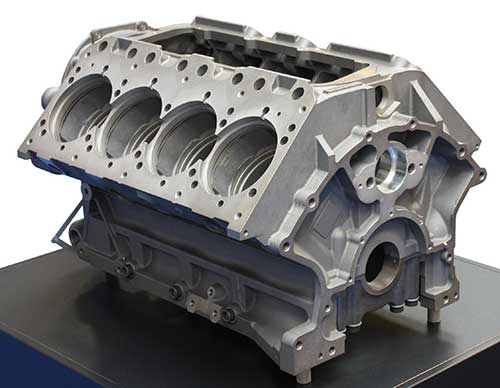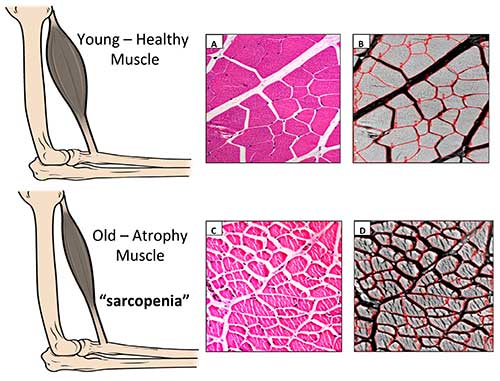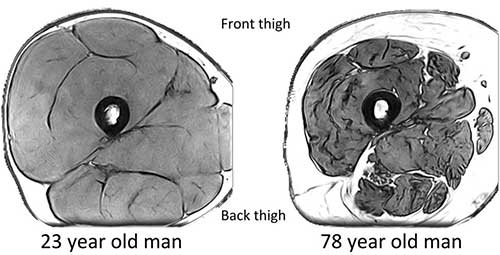So far, we have learned that drawn out, arduous workouts can derail our diet plan by giving us an insatiable appetite and cravings. Sensible eating is key, and there’s no way we’ll keep to a healthy way of eating if we are hungry all the time! We also learned how brief, High Intensity Interval or Resistance Training (HIIT or HIRT) actually suppresses appetite for hours, and even days, by releasing energy (lactate) from the working muscles for use elsewhere in the body. What’s more, intense exercise also causes hormonal changes that make it easier for fat cells to release energy in between meals.
Notice a trend here? Short, brief workouts help us manage hunger.
Don’t be “fuel efficient.”
There’s one more crucial thing exercise can do to help us be leaner and metabolically healthier. It can help us stay expensive and inefficient. That’s not a typo! Muscle is expensive to keep around, and this works in our favor to prevent that sneaky weight gain we associated with age.

When it comes to keeping the weight off, fuel efficiency isn’t your friend. When you’re young, you’re like a gas-guzzling V8 engine. No matter how much gas you put in the tank, it always seems to need a fillup. As you age, your body realizes that it doesn’t need all that horsepower any more. So it starts saving energy by shutting some of those cylinders off.
In real terms, this means that our bodies expertly avoid recruiting stronger muscle fibers if they aren’t absolutely necessary.
By doing this, our bodies reserve these “emergency” fibers for true “emergencies” such as fleeing from a predator, or chasing down dinner. This is a handy trick if you’re trying to survive a famine, as we were for most of our history, because those bigger muscle fibers are expensive to refuel and repair. Unfortunately, this hyper-efficiency does us no favors in our modern food environment, where food energy (calories) are abundant!
Over time, you lose muscle fibers because you don’t use them.
As the years go by, the body reevaluates what is and isn’t needed. Any bone stock or muscle fibers that aren’t being regularly used (deeply fatigued) simply get broken down and recycled. On an MRI, what we see is that muscles start to look marbled as muscle fibers are replaced by fatty connective tissue. Not only does this cause our functional ability to decline, but it also means our smaller, weaker muscular systems now consume less energy at rest. In other words, your metabolism gets slower, because you actually lose units of muscle.

Age-related muscle loss is called “Sarcopenia.” It explains our slowing metabolisms.
When our body gets rid of muscle tissue that it “doesn’t need” (aka, that hasn’t been used recently), this means our metabolic rate goes down. It takes energy just to maintain muscle, and when it goes away, suddenly our needs for energy go down too. Very fuel efficient! Also very bad.
Because what we don’t do when our metabolisms go down is eat less. We are still being stimulated, every day, to eat the same amounts because the foods in our modern environment are so delicious, varied, and exciting. And so even though we may be eating the same amount of food as we did in our twenties, we burn fewer calories, meaning that what used to be a maintenance diet now has extra calories in it, above our needs.

As muscles shrink, your maintenance diet becomes a fat-gaining diet.
First, let’s remember that even 50 extra calories a day (a few M&M’s) is enough to gain 5lbs of fat every year. If you lose 1 lb of muscle, this represents a loss of up to 5 calories per day, or 2200 calories each year. It only takes a small surplus – the same incremental grains that is so helpful to our investment portfolio can also be very frustrating when we step on the scale.
Resting metabolic rate also doesn’t tell the whole tale. A deeply fatigued muscle that is in the process of responding to resistance training may burn as many as 10 calories per pound at rest. This means that the difference between a muscle that is atrophying due to disuse, and one that is being stimulated through resistance training, can add up to over 3,500 calories each year, roughly the same amount of energy in one pound of body fat!
Even “active” people lose 2-4 pounds of muscle every 10 years! Strength training is the fix.
Imagine what losing 10 or 20 lbs of muscle can do to our metabolic rates! Not only will our muscles have lower energy needs because they aren’t being stimulated, but these needs will further fall as the muscles themselves shrink.

Just 60 minutes of strength training each week can stop, and even reverse, sarcopenia!
Resistance training can help people restore lost muscle tissue even into their 90’s! And luckily, it doesn’t have to take a lot of time, nor require risky activities. Just two or three short, but high effort workouts each week are enough to build and maintain healthy muscle mass, and to stop the loss of muscle and bone that disuse usually brings.
Don’t let your metabolism slow down! Do strength training!
Much of what we blame on age is actually a result of disuse. With just 20-30 minutes of resistance training, twice each week, you can stimulate your metabolism to promote fat loss, AND you can also tell your body to keep your precious, expensive muscle, so your metabolism stays youthful, and your waist stays trim!


